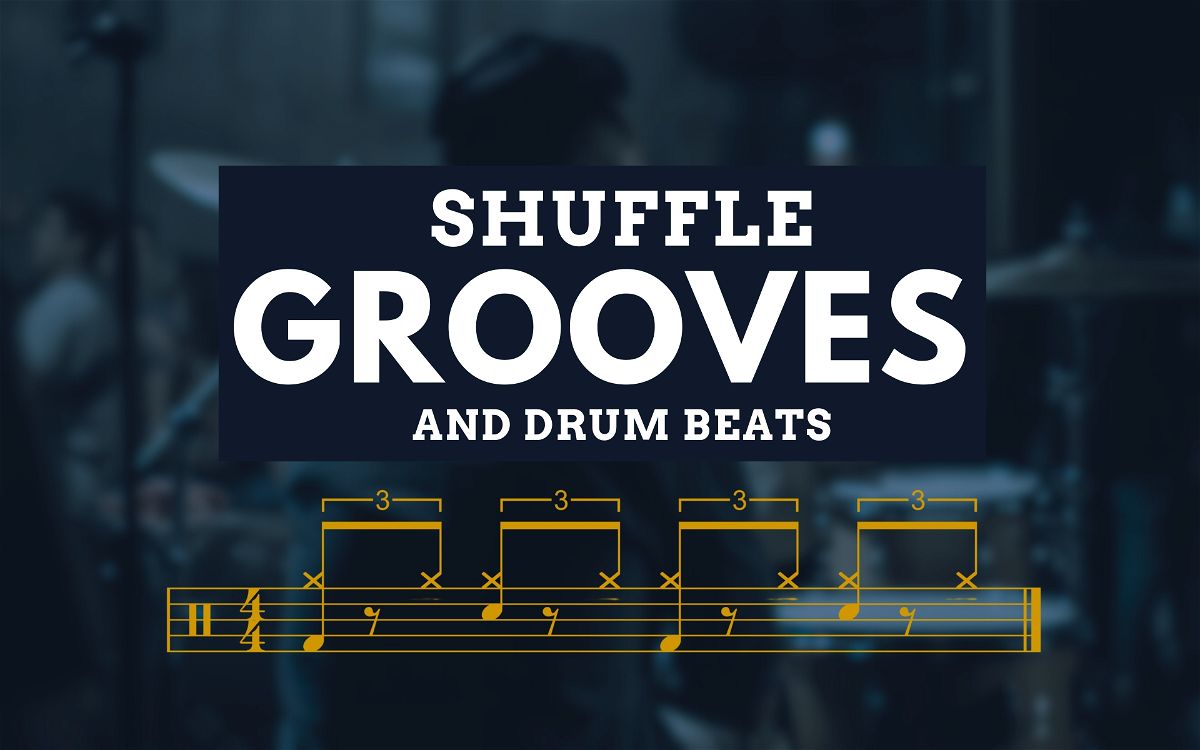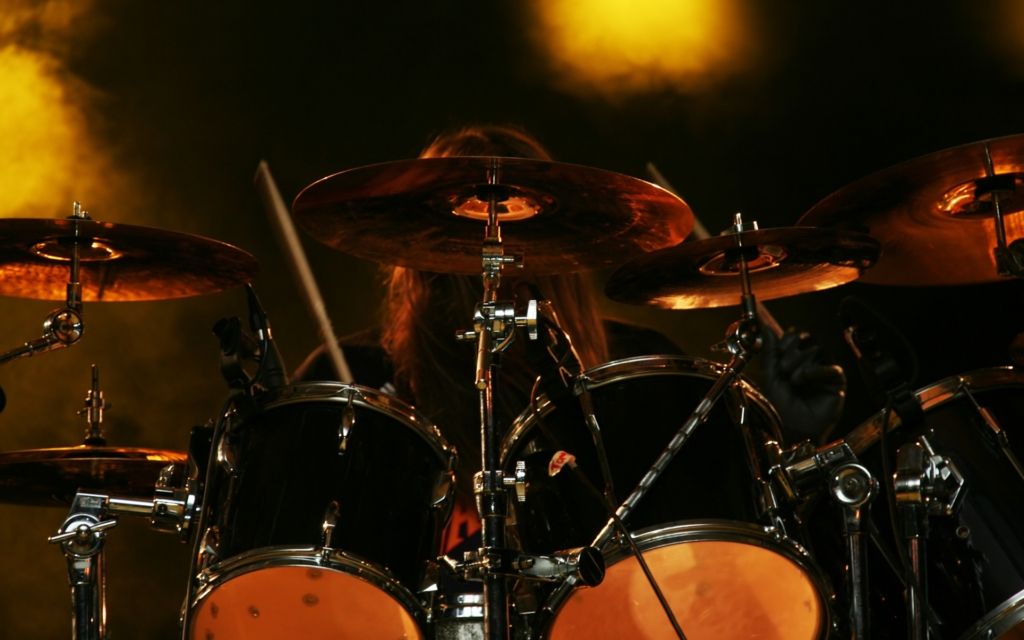Shuffles are some of the most fun drum beats to play on the drums. While people commonly think that you play them in styles like jazz, country, and funk, I’ve heard shuffles being played in almost every genre.
So, it’s a good idea to learn how to play a few shuffles so that you can pull them out whenever needed.
Contents
Half Time Shuffles vs Straight Shuffles
Before we get to the list, it’s important to understand the difference between a half-time shuffle and a straight shuffle.
In both types, you’re going to keep consistent triplet notes on the hi-hat. In a half-time shuffle, you’re going to play one main snare drum note on beat 3 of the bar.
In a straight shuffle, you’re going to play two main snare drum notes on beats 2 and 4 of the bar. That’s essentially the big difference. It often feels like half-time shuffles are slower, but they’re just a bit more spaced out.
How to Count When Playing a Shuffle
Most shuffles are written out and subdivided into triplets. You’re going to get four main counts in every bar. In each count, you’re going to get three 8th note triplet counts.
So, a single bar will have 12 notes in total.
To count those notes, you’re going to say “1 trip-let, 2 trip-let, 3 trip-let, 4 trip-let.” That’s a bit different from how you count standard 8th or 16th notes, so it takes a bit of time to get used to.
With that out of the way, let’s get to the shuffle grooves.
Beat 1

Our first groove is the most basic form of a straight shuffle. To start, you’re going to play a hi-hat on counts “1” and “let.” You’ll leave a rest on the “trip” count, and you’ll repeat that for each beat of the bar.
You’ll then play a bass drum on beats 1 and 3, and then you’ll play a snare drum on beats 2 and 4.
The most important thing to focus on here is the hi-hat pattern. It may feel uncomfortable at first, but you need to get used to playing it before moving onto any of the other grooves on this list.
Beat 2

Our next groove is another basic one. We’re now going to play an easy half-time shuffle with no ghost notes or complicated additions.
The hi-hat pattern will be the same as the last groove, but you’re only going to play the bass drum on beat 1. You’re then going to play a snare drum on beat 3.
Something that I’ve found very useful in the past is to loop between this groove and the previous straight shuffle one. That will give you a good understanding of how to play them differently.
Beat 3

This groove is a straight shuffle with a bit of flair. You’re going to add a couple of kick drum notes to deepen the sound a bit.
On beat 1, you’re going to play bass drums on the “1” and “let” counts. That means that they’ll match what you’re playing with the hi-hats. You’ll then do the same thing on beat 3.
You’ll keep things the same on beats 2 and 4 with the snare drum landing on the backbeat counts.
The trickiest part of this groove is keeping your bass drum and hi-hat notes in sync. It will sound a bit sloppy if they’re not played at the exact same time.
Beat 4

For our last simple groove on this list, you’re going to do the same thing by adding an extra kick drum to a half-time shuffle.
The groove will be the same as the one we played in beat 2 on this list, but you’re going to place the extra kick drum note on the “let” count of beat 2 of the bar.
While this doesn’t have any ghost notes, this is essentially the basic groove that everyone reverts to when they want to play a half-time shuffle.
Beat 5

Now, let’s move on to some famous shuffle grooves. This first one is commonly referred to as The Texas Shuffle.
The first thing you’ll notice is that it has a lot of ghost notes. You’re going to play ghost notes on the snare drum at the same time that you play the notes on the hi-hat. You’re just going to accent beats 2 and 4 to create a recurring backbeat.
You’re also going to play a bass drum on all of the quarter note counts of the bar.
The hardest aspect here is to play a strong snare drum directly after the ghost note before beat 2.
Beat 6

This is one of the most famous half-time shuffle grooves ever. In fact, it’s what most people refer to as the original half-time shuffle, and it was first played by Bernard Purdie decades ago. It’s called the Purdie Shuffle, and I’d argue that it’s the most important groove on this entire list.
The main theme of this groove is that there are ghost notes on all of the “trip” counts of each beat. You’re then going to fill the rest in with bass drums and an accented snare on beat 3.
If you want a better understanding of this groove, you should check the YouTube videos out of Bernard Purdie explaining it himself. They’re incredibly entertaining!
Beat 7

This groove puts a slight twist on the Purdie Shuffle. Instead of playing the loud snare drum on beat 3, you’re going to play it on the “trip” count of beat 3. This is called displacement, as you’ve moved that note slightly forward in the bar.
Everything else will stay the same, but you’ll sound more like Matt Garstka than Bernard Purdie when playing this!
Beat 8

Up next we have the Fool in the Rain shuffle groove. This was played by John Bonham with Led Zeppelin.
It’s heavily inspired by the Purdie Shuffle, but you’re going to add an open hi-hat on the “let” count of beat 1. You’re also going to play the bass drum to match it.
Opening your hi-hat at that particular spot in the bar often feels hard for drummers, so take it slowly. And then if you really want to sound like John Bonham, make sure to play the accented snare as loudly as possible on beat 3.
Beat 9

Here’s the last famous shuffle to mention on this list – The Rosanna Shuffle. This was played by Jeff Porcaro for Toto’s song, Rosanna. Unlike every other groove on this list, it’s phrased over two bars instead of just one.
It’s also meant to be played a lot faster, so I’d argue that it’s the hardest half-time shuffle groove to learn.
It’s similar to the Purdie Shuffle, but the bass drum placements are a bit different. In the actual song, Jeff Porcaro moves those bass drums around constantly. So, learn to play what I’ve written out here, but then try to improvise a bit with your kick drum.
Beat 10

This shuffle groove has a certain technique that a lot of modern drummers like to play. It involves playing three snare drum notes in a row. The first two will be ghost notes, and the last one will be an accented rimshot.
A good drummer to reference here would be Zack Graybeal (aka ZackGrooves). He plays this sort of thing all the time.
It sounds amazing, but it can be tricky to play at higher speeds!
Beat 11

Here’s another variation of the Purdie Shuffle. The big difference is that you’re going to play more on your hi-hat instead of filling the bar in with ghost notes.
A lot of people are very accustomed to hearing ghost notes in half-time shuffle grooves, so this one always sounds quite fresh and inspiring.
I’d recommend flicking your left wrist to fill in those hi-hat notes instead of pulling your arm up to play them. It makes it easier to get to higher speeds.
Beat 12

Our final groove is another challenging one. We’re going to stick with the idea of playing more hi-hat notes than usual, but we’re also going to add two open hi-hats to spice things up.
Those open hi-hats will land on the “let” counts of beats 1 and 3. You’ll need to make sure to close your hi-hats on beats 2 and 4 to make the groove sound clean.
Conclusion
One of the key aspects of playing a good shuffle is having great control over your ghost notes. If your left hand feels like it’s struggling in these grooves, that’s something you need to work on.
After that, I’d recommend focusing on how the grooves feel when you play them. Musicality is a big aspect of playing shuffle grooves, and it mainly centers around dynamics.
Make sure that your ghost notes are light and your rimshots are loud. Hearing that difference will make the grooves both feel and sound better.
Lastly, try to play these beats along with music. That will make them feel more comfortable to play after a while.









